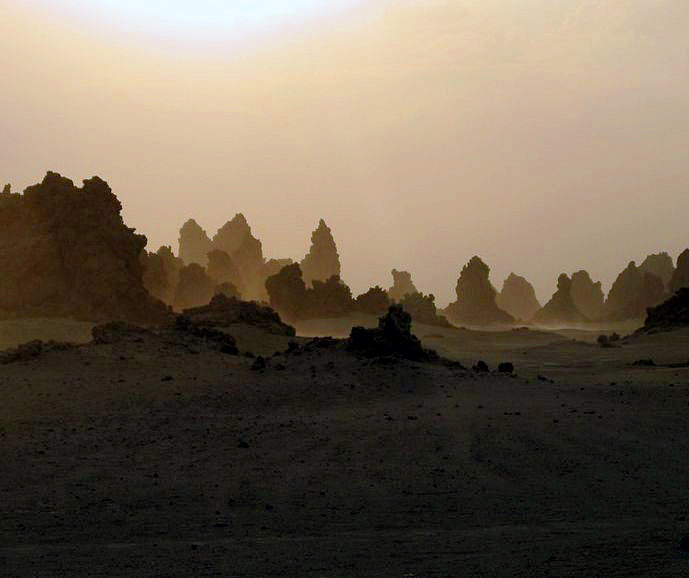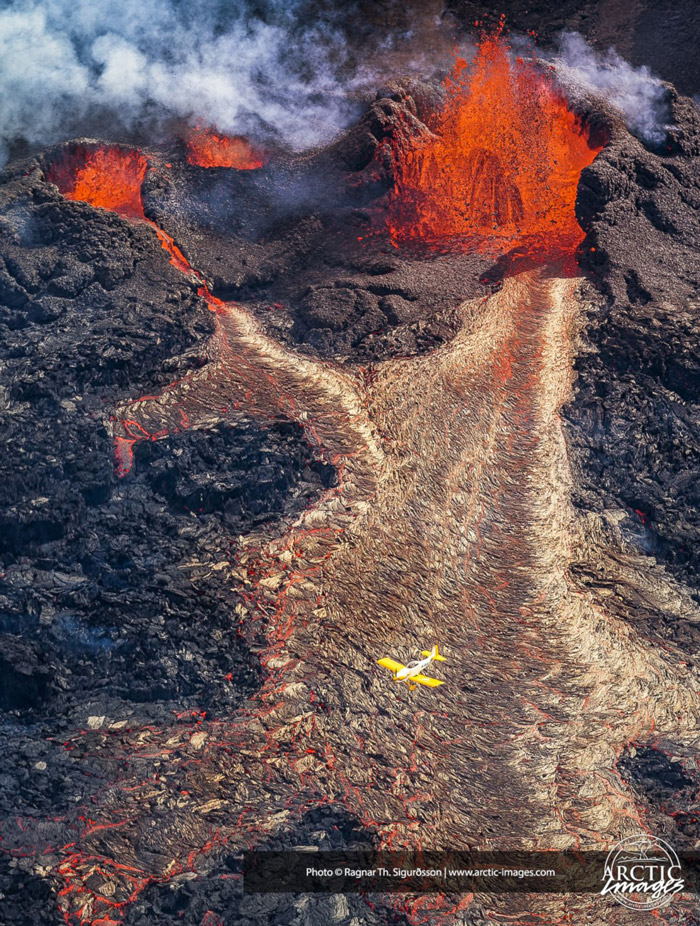Hole in the Clouds
Jul 13, 2013
 Years of drought have drastically lowered the water level of Lake Abbe, along the border between Djibouti and Ethiopia in the Horn of Africa. Vast stretches of what used to be lake bottom are now exposed, including clusters of limestone formations like these, many of which are chimneys venting sulfuric steam.
Years of drought have drastically lowered the water level of Lake Abbe, along the border between Djibouti and Ethiopia in the Horn of Africa. Vast stretches of what used to be lake bottom are now exposed, including clusters of limestone formations like these, many of which are chimneys venting sulfuric steam.
The chimneys formed when the vents were underwater; heat from the steam caused minerals to precipitate out of the lake water and build up around the rims of the vents.
Lake Abbe is a salt lake, the lowest point of a desert drainage system that has nowhere to drain. It's full of steam and sulfur because it's probably the birthplace of a new ocean, a triple junction of spreading faults where three tectonic plates are being pulled relentlessly apart from one another. Two of the faults are already so deep that they are full of ocean water: the Red Sea and the Gulf of Aden. The third fault stretches south from Lake Abbe through eastern Africa as a chain of lakes and deep depressions: the East African Rift.
Along these faults, tectonic plates are pulling apart from one another at rates approaching an inch a year, thinning out the earth's crust in the region, and generating much volcanic activity and gaseous emissions. The geologic evidence strongly supports the likelihood that someday the land around Lake Abbe will be thousands of feet underwater, near the middle of a big blue sea.
But it will take a while. Rifting began here about 60 million years ago. At current rates of divergence, the new basin is spreading roughly 10 miles every million years. In another 100 million years, we'll have an ocean about a thousand miles across.
The drought may (or may not) be over by then.
landscape
geology
Lake Abbe
triple junction
tectonics
Djibouti
limestone
Horn of Africa
(Image credit:
Sep 15, 2014
 Tectonic drama is vividly on display these days in central Iceland, where the trailing edges of two continental plates–the North American and Eurasian plates–are tearing the island apart.
Tectonic drama is vividly on display these days in central Iceland, where the trailing edges of two continental plates–the North American and Eurasian plates–are tearing the island apart.
The Atlantic Ocean is growing wider and wider, at an average rate of about an inch a year. The seafloor bulges upward in the middle, where the tectonic plates meet, and cracks develop in the bulging ridge. These fissures fill up immediately with magma squirted up from deep below the earth's crust.
When the magma erupts at the surface–at which point it's called lava instead of magma–it cools and hardens into new rock, lodged in between the edges of the two old plates. This process, called rifting, pushes the plates further and further apart.
Iceland is one of the few places on earth where rifting is visible above the water. The fissure eruption currently active near a large old volcano called Bardarbunga is not particularly explosive–no threat to airplanes at the moment–and it is occurring in an unpopulated area where there is little risk to people or property. In fact, the scene of the eruption is a desolate plain called Hohluraun, which is covered with old lava from ancient eruptions.
There is concern that the fissure may "unzip" back toward Bardarbunga, in which case the eruption could spread underneath hundreds of meters of snow and ice in Europe's largest glacier. Much of the glacier could be vaporized by the heat of the eruption, creating a massive steam explosion and ash cloud.
There is also concern that the lava erupting from the fissure is emptying out the old magma chamber underneath Bardarbunga volcano, which is the largest in Iceland. Ongoing earthquakes are readjusting the mountain as the partially empty magma chamber caves in on itself; if one of the earthquakes breaches the chamber, the explosion and eruption could become as large as any in recorded history. Bardarbunga's last eruption was the largest in the past 10,000 years.
But it won't be apocalyptic; it won't extinguish life as we know it. It will just darken the skies for a while and widen the Atlantic Ocean by a bit.
Or: the current fissure eruption could die down in a day or a month or a year, leaving central Iceland quiet and relocating the scene of the next tectonic drama to some other time and place.
volcano
Iceland
tectonics
Bardabunga
graben
fissure eruption
rifting
(Image credit: Ragnar Siguurdsson at Arctic-Images.com)
Feb 25, 2015
 Icelandic authorities reported this week that the five-month-old volcanic eruption known as Holuhraun shows numerous signs of winding down, at least for the moment. They believe that volcanism in that part of the country is entering a new phase
Icelandic authorities reported this week that the five-month-old volcanic eruption known as Holuhraun shows numerous signs of winding down, at least for the moment. They believe that volcanism in that part of the country is entering a new phase
The lava flow has decreased dramatically. After spilling wildly for months over an area the size of a large city, the lava now is mostly pooling in a single crater before it trickles out across the landscape.
The population of Iceland is no longer suffering from the volcano's poisonous gases, though gas concentrations in the immediate vicinity of the eruption are still at deadly levels. It has been two weeks since any populated area experienced serious atmospheric pollution.
Earthquake activity associated with the eruption is way down, though officials still describe it as very high. Yesterday, about 25 earthquakes shook the region, all smaller than 3.0. Until recently, the daily count was usually 80 or more, some of them above magnitude 5.0.
Holuhraun has been fed with magma from a chamber underneath Iceland's largest volcano, the glacier-covered Bardarbunga. As the magma chamber emptied out, Bardarbunga mountain began collapsing in on itself, subsiding more than 100 meters since measurements began in September. The rate of subsidence has dramatically slowed in recent weeks; yesterday, it was just 2 cm.
Clearly, Holuhraun is running on fumes now and is likely to cease significant eruption in the near future. But volcanologist Armann Hoskuldsson cautions that the overall volcanic episode may not be anywhere near complete and in fact may be just now entering a much more active phase.
Tectonically, the Holuhraun eruption involves rifting; the lava is actually creating new land in between two diverging tectonic plates. Hoskuldsson notes that rifting episodes last much longer than five months–usually at least ten years–and they typically involve multiple eruptions, often much more ferocious than Holuhraun.
Iceland
tectonics
rifting
eruption
volcano. Bardarbunga
fissure
Holuhraun
(Image credit: Ólafur Sigurjónsson)
 Years of drought have drastically lowered the water level of Lake Abbe, along the border between Djibouti and Ethiopia in the Horn of Africa. Vast stretches of what used to be lake bottom are now exposed, including clusters of limestone formations like these, many of which are chimneys venting sulfuric steam.
Years of drought have drastically lowered the water level of Lake Abbe, along the border between Djibouti and Ethiopia in the Horn of Africa. Vast stretches of what used to be lake bottom are now exposed, including clusters of limestone formations like these, many of which are chimneys venting sulfuric steam.
 Icelandic authorities reported this week that the five-month-old volcanic eruption known as Holuhraun shows numerous signs of winding down, at least for the moment. They believe that volcanism in that part of the country is entering a new phase
Icelandic authorities reported this week that the five-month-old volcanic eruption known as Holuhraun shows numerous signs of winding down, at least for the moment. They believe that volcanism in that part of the country is entering a new phase